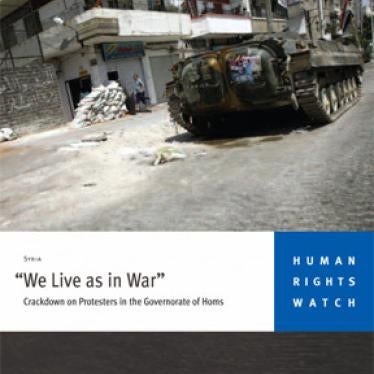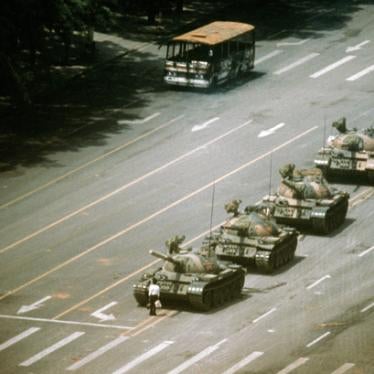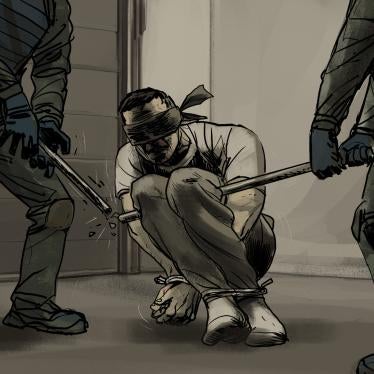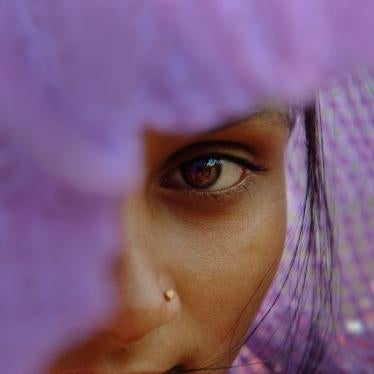(New York) – The systematic nature of abuses against civilians in Homs by Syrian government forces, including torture and unlawful killings, indicate that crimes against humanity have been committed, Human Rights Watch said in a new report released today. Human Rights Watch urged the Arab League, meeting in Cairo on November 12, 2011, to suspend Syria’s membership in the League and to ask the United Nations Security Council to impose an arms embargo and sanctions against individuals responsible for the violations, and refer Syria to the International Criminal Court.
The 63-page report, “‘We Live as in War’: Crackdown on Protesters in the Governorate of Homs,” is based on more than 110 interviews with victims and witnesses from Homs, both the city and the surrounding governorate of the same name. The area has emerged as a center of opposition to the government of President Bashar al-Assad. The report focuses on violations by Syrian security forces from mid-April to the end of August, during which time security forces killed at least 587 civilians, the highest number of casualties for any single governorate.
Security forces have killed at least another 104 people in Homs since November 2, when the Syrian government agreed to the Arab League initiative for a political solution. Arab foreign ministers will meet in an emergency session on November 12 to discuss Syria’s failure to comply with the Arab League initiative.
“Homs is a microcosm of the Syrian government’s brutality,” said Sarah Leah Whitson, Middle East director at Human Rights Watch. “The Arab League needs to tell President Assad that violating their agreement has consequences, and that it now supports Security Council action to end the carnage.”
Homs has emerged as the most restive governorate in Syria since anti-government protests erupted in mid-March. Human Rights Watch documented dozens of incidents in which security forces and government-supported militias violently attacked and dispersed overwhelmingly peaceful protests. A woman who participated with her 3-year-old son in a protest in the Homs neighborhood of Bab Dreib on August 15 described how they came under attack:
We went out in a peaceful protest with the whole family about 10:30 or 11 p.m. It was calm, so everything seemed ok. Then two cars showed up suddenly and opened fire, targeting people even as they were ducking and lying on the ground. They were white Kia Cerato cars with tinted windows, like those used by Air Force intelligence. The guns were machine guns. My husband leaned over our son to protect him, but the bullet entered our boy’s stomach. The doctors were able to remove the bullet, but it left a lot of damage.
Security forces have also conducted large-scale military operations in several towns in the governorate, including Tal Kalakh and Talbiseh as well as the city of Homs, resulting in many deaths and injuries. Typically, security forces used heavy machine guns, including anti-aircraft guns mounted on armored vehicles, to fire into neighborhoods to frighten people before entering with armored personnel carriers and other military vehicles. They cut off communications and established checkpoints restricting movement in and out of neighborhoods and the delivery of food and medicine. One resident of Bab Sba`, a part of the city particularly affected by the violence, described how security forces encircled the neighborhood:
Security forces blocked off Bab Sba` completely on July 21. Cars trying to get through were shot at from heavy military vehicles and pedestrians and bicycles were shot at by snipers. When we tried to bring food and medicine into the area on the morning of July 21, security forces opened fire. They killed one person, wounded a second, and arrested the third.
As in much of the rest of Syria, security forces in Homs governorate subjected thousands of people to arbitrary arrests, enforced disappearances, and systematic torture in detention. While most were released after several weeks in detention, several hundred remain missing. Most detainees were young men in their 20s or 30s, but security forces also detained children, women, and elderly people. Several witnesses reported that their parents or even grandparents – people in their 60s and 70s – had been detained.
Torture of detainees is rampant. Twenty-five former detainees from Homs were among those interviewed by Human Rights Watch. They all reported being subjected to various forms of torture. Human Rights Watch has independently documented 17 deaths in custody in Homs, at least 12 of which were clearly from torture. Data collected by local activists suggest even higher figures. They say that at least 40 people detained in Homs governorate died in custody between April and August.
Former detainees reported security forces’ use of heated metal rods to burn various parts of their bodies, the use of electric shocks, the use of stress positions for hours or even days at a time, and the use of improvised devices, such as car tires (locally known as dulab), to force detainees into positions that make it easier to beat them on sensitive parts of the body, like the soles of the feet and head. One witness described the torture he experienced at the Military Intelligence base in Homs:
They brought me into what felt like a big room with lots of people inside. I was blindfolded but could hear people around me screaming and begging for water. I could hear the sound of electric stun guns and interrogators ordering to hang people by their hands. Once they got to me, they started mocking me, saying, “We welcome you, leader of the revolution,” and asked me what was going on in Tal Kalakh. I said I didn’t know, and then the torture began.
They beat me with cables and then hanged me by my hands from a pipe under the ceiling so that my feet weren’t touching the floor. I was hanging there for about six hours, although it was hard to tell the time. They were beating me, and pouring water on me, and then using electric stun guns. For the night, they put me into a cell, about 3-by-3 meters, along with some 25 other detainees. We were all squeezed together. The next morning, they brought me in for another interrogation. This time, they “folded” me, pushed my legs and head into a tire, flipped me on my back, and started flogging the soles of my feet.
One of the most worrisome features of the intensifying crackdown has been the growing number of deaths in custody. In almost all of the 17 deaths in custody that Human Rights Watch was able to confirm independently, witnesses said they had no information concerning their relatives’ fate or whereabouts after security forces detained them at a protest or checkpoint until the day they received a call, usually from a local public hospital, asking them to pick up the body. In at least 12 cases in which Human Rights Watch reviewed photos or video footage of the bodies, they bore unmistakable marks consistent with torture, including bruises, cuts, and burns.
Syrian authorities have repeatedly claimed that the violence in Homs has been carried out by armed terrorist gangs, incited and sponsored from abroad. Protesters appear to have been unarmed in most incidents, Human Rights Watch found, but armed defectors from security forces did intervene on some occasions after protesters came under fire from security forces.
Local residents told Human Rights Watch that since June, army defections had increased and that many neighborhoods had about 15 to 20 defectors who would sometimes intervene to protect protesters when they heard gunfire. In addition, the security forces’ violent crackdown and increasing sectarian mistrust have led residents of some neighborhoods in the city of Homs, notably Bab Sba` and Bab `Amro, to organize in local defense committees that are often armed, mostly with firearms but in some cases with rocket propelled grenades (RPGs).
Violence by protesters or defectors deserves further investigation. However, these incidents by no means justify the disproportionate and systematic use of lethal force against demonstrators, which clearly exceeded any justifiable response to any threat presented by overwhelmingly unarmed crowds. Nor would the existence of armed elements in the opposition justify the use of torture and arbitrary, incommunicado detention.
The decision of some protesters and defectors to arm themselves and fight back shows that the strategy adopted by Syria’s authorities has provoked a dangerous escalation in the level of violence, and highlights the need for the international community to ensure an immediate cessation of lethal force lest the country slip into bloodier conflict, Human Rights Watch said.
SANA, the Syrian official news agency, reported on November 6 that on the occasion of Eid al-Adha, the authorities had released 553 detainees “who were involved in the current events with no blood on their hands.” But authorities published no names and three lawyers representing human rights and political activists told Human Rights Watch separately that none of their clients had been released.
Selected Accounts from “‘We Live as in War’: Crackdown on Protesters in the Governorate of Homs”:
Mohammed (not his real name), whose 21-year-old cousin was among 16 killed when security forces and pro-government militias attacked people who had gathered for a funeral near the Khaled Bin al-Waleed mosque in Homs on July 19, told Human Rights Watch:
As we were burying the dead, I suddenly heard gunshots. Four pick-up vehicles with people in uniforms, helmets, and body armor drove up, shooting at the people with their automatic guns and guns mounted on the vehicles. We started running away. The mother and brother of one of the dead were killed next to his coffin. My cousin tried to drag the mother’s body away. He suddenly fell, but I didn’t know at that time that he had been hit. As I was running away I saw an armored personnel carrier also shooting. I don’t know whether they were shooting in the air or at the crowd.
In a similar incident, security forces attacked protesters without warning in the Khalidiyya neighborhood in Homs on August 5. Maher (not his real name), a protester, recounted the incident to Human Rights Watch:
We walked through the street after Friday prayers, passing the checkpoint run by Air Force intelligence and military forces. They made note of us. After we passed, they started shooting along the street. Some old people had stayed in the mosque, but when they tried to leave the forces fired even on them, on everyone passing in the street. They shot one man in his leg. Another man, an old man, tried to help him, but they shot him in the hand.
Mahmud (not his real name), said that he fled from his house in Homs when the security forces came to his neighborhood on May 15, but they took away his 51-year-old father. He said:
I was hiding in a house across the street and saw that they broke into our house and dragged my father out. They pushed him on the ground and started beating him, demanding that he praise Bashar al-Assad. He had to do it. They were about 10 to 15 men, some in military uniforms, with special forces badges, and some in black uniforms and white sneakers; I believe these were from mukhabarat. They blindfolded him and took him away in a taxi. For 24 days we had no information about his whereabouts, and then my uncle found him in the central jail in Homs, and managed to get him released on bail. When he was released his front teeth were broken and his face and eyes were swollen.
One witness, Abu Adam, who was detained in early July along with 11 other protesters from the Khalidiyya neighborhood in Homs, described to Human Rights Watch the conditions in a State Security detention facility in Homs:
The conditions were horrible. The cell measured 1.7 by two meters. There were eight of us there. There was a tiny window high up on the wall, but it provided no light or air. We had to take turns sleeping on each other’s shoulders. There was no place to lie down. I was dripping with sweat from head to toe. They gave us two loafs to share twice a day and a bottle of water. Twice a day they gave us 10 seconds to use the toilet.
Basel (not his real name), gave an account of the torture he experienced at the Military Intelligence detention facility in Homs:
When I did not answer all their questions during interrogation, they took me to a torture room. My eyes were blindfolded, but I recall going five steps down. They used handcuffs to tie one of my arms to a pipe under the ceiling and left me hanging there, with my feet barely touching the ground. They left me there for two or three hours. They did this over eight days. There were usually five or six detainees tortured that way at any given moment. I could not see them but I could hear their screams. Sometimes, they would also beat me while hanging. My wrist, arm, and shoulder would hurt so much, that I tried at one point to break my arm so that they would have to take me down.
Fadi (not his real name), from the town of al-Qusair outside of Homs, told Human Rights Watch about the death of a family friend, 35-year-old Ahmad al-Masri. He said that al-Masri was mentally disabled and that in late May or early June security forces had arrested him as he walked around the streets, randomly repeating anti-government slogans he heard at the protests. Fadi said:
A week after he was detained, his body was returned to his parents. I saw the body when it was brought in. It was covered in bruises and oval red and blue marks that seemed to be from electric shocks, mostly on his back. His ribs were broken –some of the ribs were sticking out of his body. His father said that he had been called into the central facility of the Military Intelligence in Homs and made to sign a statement saying that Ahmad had been killed by “extremists.” He said the security forces threatened to otherwise not only keep the body but also “go after his daughters.” So he had no choice but to sign it.








